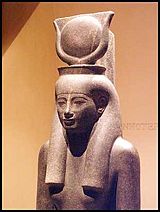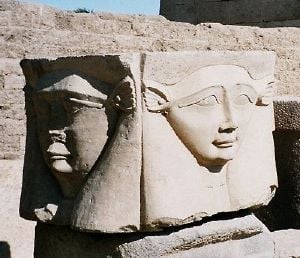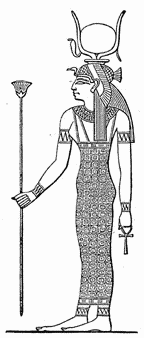Difference between revisions of "Hathor" - New World Encyclopedia
Chris Jensen (talk | contribs) m |
m (Robot: Remove date links) |
||
| Line 3: | Line 3: | ||
[[Image:Egypt.Hathor.jpg|thumb|right|160px|Statue of Hathor (Luxor Museum)]] | [[Image:Egypt.Hathor.jpg|thumb|right|160px|Statue of Hathor (Luxor Museum)]] | ||
| − | In [[Egyptian mythology]], '''Hathor''' ([[Egyptian language|Egyptian]] for ''house of [[Horus]]'') was originally a personification of the [[Milky Way]], which was seen as the milk that flowed from the [[udder]]s of a heavenly [[cow]]. Hathor was an ancient goddess, worshipped as a cow-deity from at least | + | In [[Egyptian mythology]], '''Hathor''' ([[Egyptian language|Egyptian]] for ''house of [[Horus]]'') was originally a personification of the [[Milky Way]], which was seen as the milk that flowed from the [[udder]]s of a heavenly [[cow]]. Hathor was an ancient goddess, worshipped as a cow-deity from at least 2700 B.C.E., during the [[Second dynasty of Egypt|2nd dynasty]], and possibly even by the [[King Scorpion|Scorpion King]]. The name ''Hathor'' refers to the encirclement by her, in the form of the [[Milky Way]], of the night sky and consequently of the god of the sky, [[Horus]].{{Fact|date=February 2007}} She was originally seen as the daughter of [[Ra]], the creator whose own cosmic birth was formalised as the [[Ogdoad]] [[cosmogeny]]. |
An alternate name for her, which persisted for 3,000 years, was '''Mehturt''' (also spelt '''Mehurt''', '''Mehet-Weret''', and '''Mehet-uret'''), meaning ''great flood'', a direct reference to her being the milky way.{{Fact|date=February 2007}} The Milky Way was seen as a waterway in the heavens, sailed upon by both the sun god and the king, leading the [[Egyptians]] to describe it as ''The Nile in the Sky''. Due to this, and the name ''mehturt'', she was identified as responsible for the yearly inundation of the [[Nile]]. Another consequence of this name is that she was seen as a herald of imminent birth, as when the [[amniotic sac]] breaks and floods its waters, it is a medical indicator that the child is due to be born extremely soon. | An alternate name for her, which persisted for 3,000 years, was '''Mehturt''' (also spelt '''Mehurt''', '''Mehet-Weret''', and '''Mehet-uret'''), meaning ''great flood'', a direct reference to her being the milky way.{{Fact|date=February 2007}} The Milky Way was seen as a waterway in the heavens, sailed upon by both the sun god and the king, leading the [[Egyptians]] to describe it as ''The Nile in the Sky''. Due to this, and the name ''mehturt'', she was identified as responsible for the yearly inundation of the [[Nile]]. Another consequence of this name is that she was seen as a herald of imminent birth, as when the [[amniotic sac]] breaks and floods its waters, it is a medical indicator that the child is due to be born extremely soon. | ||
| Line 41: | Line 41: | ||
[[Image:Hathor-Meyers.png|thumb|right|160px|Hathor (in her human form)]] | [[Image:Hathor-Meyers.png|thumb|right|160px|Hathor (in her human form)]] | ||
| − | Hathor was worshipped in [[Canaan]] in the [[11th century B.C.E.]], which at that time was ruled by Egypt, at her holy city of [[Hazor]], which the [[Old Testament]] claims was destroyed by [[Joshua]] ([[Book of Joshua|Joshua]] 11:13, 21). The Sinai Tablets show that the Hebrew workers in the mines of [[Sinai Peninsula|Sinai]] about | + | Hathor was worshipped in [[Canaan]] in the [[11th century B.C.E.]], which at that time was ruled by Egypt, at her holy city of [[Hazor]], which the [[Old Testament]] claims was destroyed by [[Joshua]] ([[Book of Joshua|Joshua]] 11:13, 21). The Sinai Tablets show that the Hebrew workers in the mines of [[Sinai Peninsula|Sinai]] about 1500 B.C.E. worshipped Hathor, whom they identified with the goddess [[Astarte]]. Some theories state that the [[golden calf]] mentioned in the Bible was meant to be a statue of the goddess Hathor ([[Exodus]] 32:4-32:6.). |
The [[Greeks]] also loved Hathor and equated her with their own goddess of love and beauty, [[Aphrodite]]. | The [[Greeks]] also loved Hathor and equated her with their own goddess of love and beauty, [[Aphrodite]]. | ||
Revision as of 01:01, 4 September 2007
In Egyptian mythology, Hathor (Egyptian for house of Horus) was originally a personification of the Milky Way, which was seen as the milk that flowed from the udders of a heavenly cow. Hathor was an ancient goddess, worshipped as a cow-deity from at least 2700 B.C.E., during the 2nd dynasty, and possibly even by the Scorpion King. The name Hathor refers to the encirclement by her, in the form of the Milky Way, of the night sky and consequently of the god of the sky, Horus.[citation needed] She was originally seen as the daughter of Ra, the creator whose own cosmic birth was formalised as the Ogdoad cosmogeny.
An alternate name for her, which persisted for 3,000 years, was Mehturt (also spelt Mehurt, Mehet-Weret, and Mehet-uret), meaning great flood, a direct reference to her being the milky way.[citation needed] The Milky Way was seen as a waterway in the heavens, sailed upon by both the sun god and the king, leading the Egyptians to describe it as The Nile in the Sky. Due to this, and the name mehturt, she was identified as responsible for the yearly inundation of the Nile. Another consequence of this name is that she was seen as a herald of imminent birth, as when the amniotic sac breaks and floods its waters, it is a medical indicator that the child is due to be born extremely soon.
Hathor was also favoured as a protector in desert regions (see Serabit el-Khadim).
Some egyptologists associate Hathor with artificial light[citation needed] as evidenced by what has been purported to be a representation of an electric lamp in a temple dedicated to her worship (see Hathor temple). Though other scholars believe the representation to be that of a lotus flower, spawning a snake within (see Hathor temple).
Musician
Eventually, Hathor's identity as a cow, meant that her Hathor became identified with another ancient cow-goddess of fertility, Bata. It still remains an unanswered question amongst Egyptologists as to why Bata survived as an independent goddess for so long. Bata was, in some respects, connected to the Ba, an aspect of the soul, and so Hathor gained an association with the afterlife. It was said that, with her motherly character, she greeted the souls of the dead in the underworld, and proffered them with refreshments of food, and of drink. She was also sometimes described as mistress of the acropolis.
The assimilation of Bata, who was associated with the sistrum, a musical instrument, brought with it an association with music. In this form, Hathor's cult became centred in Dendera and was led by priests who were also dancers, singers, and other entertainers. Hathor's temple at Dendera contains an image, that has come to be known as the Dendera Light, which some have controversially claimed may be a depiction of an electric lamp. Hathor also became associated with the menat, the turquoise musical necklace often worn by women. A hymn to Hathor says:
- Thou art the Mistress of Jubilation, the Queen of the Dance, the Mistress of Music, the Queen of the Harp Playing, the Lady of the Choral Dance, the Queen of Wreath Weaving, the Mistress of Inebriety Without End.
Essentially, Hathor had become a goddess of Joy, and so she was deeply loved by the general population, and truly revered by women, who aspired to embody her multifaceted role as wife, mother, and lover. In this capacity, she gained the titles of Lady of the House of Jubilation, and The One Who Fills the Sanctuary with Joy. The worship of Hathor was so popular that more festivals were dedicated to her honour than any other Egyptian deity, and more children were named after this goddess than any other. Even Hathor's priesthood was unusual, in that both men and women became her priests.
Bloodthirsty warrior
The Middle Kingdom was founded when Upper Egypt's Pharaoh, Mentuhotep II, took control over Lower Egypt, which had become independent during the First Intermediate Period by force. This unification had been achieved by a brutal war that was to last some 28 years, but when it ceased, calm returned, and the reign of the next Pharaoh, Mentuhotep III, was peaceful, and Egypt once again became prosperous. A tale, from the perspective of Lower Egypt, developed around this.
In the tale, Ra (representing the Pharaoh of Upper Egypt) was no longer respected by the people (of Lower Egypt) and they ceased to obey his authority, which made him so angry that he sent out Sekhmet (war goddess of Upper Egypt) to destroy them, but Sekhmet was so bloodthirsty that she could not be stopped. Ra pours blood-coloured beer on the ground, tricking Sekhmet, who thinks to be blood, into drinking it, which makes her stop the slaughter, and become loving, and kind.
The form that Sekhmet had become by the end of the tale was identical in character to Hathor, and so a cult arose, at the start of the Middle Kingdom, which dualistically identified Sekhmet with Hathor, making them one goddess, Sekhmet-Hathor, with two sides. Consequently, Hathor, as Sekhmet-Hathor, was sometimes depicted as a lioness. Sometimes this joint name was corrupted to Sekhathor (also spelt Sechat-Hor, Sekhat-Heru), meaning (one who) remembers Horus (the uncorrupted form would mean (the) powerful house of Horus. However, the two goddesses were so different, indeed almost diametrically opposed, that the identification did not last.
Wife of Thoth
When Horus was identified as Ra, under the name Ra-Herakhty, Hathor's position became unclear, since she had been the wife of Ra, but mother of Horus. Many attempts to solve this gave Ra-Herakhty a new wife, Ausaas, to solve this issue around who Ra-Herakhty's wife was. However, this left open the question of how Hathor could be his mother, since this would imply that Ra-Herakhty was a child of Hathor, rather than a creator.
In areas where the cult of Thoth was strong, Thoth was identified as the creator, leading to it being said that Thoth was the father of Ra-Herakhty, thus Hathor, as the mother of Ra-Herakhty, was in this version referred to as Thoth's wife. Since Ra-Herakhty was, in this version of the Ogdoad cosmogeny, depicted as a young child, often referred to as Neferhor, when considered the wife of Thoth, Hathor was often depicted as a female nursing a child.
Since Thoth's wife had earlier been considered to be Seshat, Hathor began to be attributed with many of Seshat's features. Since Seshat was associated with records, and with acting as witness at the judgement of souls, these aspects became attributed to Hathor, which, together with her position as goddess of all that was good, lead to her being described as the (one who) expels evil, which in Egyptian is Nechmetawaj also spelt Nehmet-awai, and Nehmetawy). Nechmetawaj can also be understood to mean (one who) recovers stolen goods, and so, in this form, she became goddess of stolen goods.
Outside the Thoth cult, it was considered important to retain the position of Ra-Herakhty (i.e. Ra) as self-created (via only the primal forces of the Ogdoad). Consequently, Hathor could not be identified as Ra-Herakhty's mother. Hathor's role in the process of death, that of welcoming the newly dead with food and drink, lead, in such circumstances, to her being identified as a jolly wife for Nehebkau, the guardian of the entrance to the underworld, and binder of the Ka. Nethertheless, in this form, she retained the name of Nechmetawaj, since her aspect as a returner of stolen goods was important to society, and so considered worth noting.
Hathor outside the Nile river in Egypt
Hathor was worshipped in Canaan in the 11th century B.C.E., which at that time was ruled by Egypt, at her holy city of Hazor, which the Old Testament claims was destroyed by Joshua (Joshua 11:13, 21). The Sinai Tablets show that the Hebrew workers in the mines of Sinai about 1500 B.C.E. worshipped Hathor, whom they identified with the goddess Astarte. Some theories state that the golden calf mentioned in the Bible was meant to be a statue of the goddess Hathor (Exodus 32:4-32:6.).
The Greeks also loved Hathor and equated her with their own goddess of love and beauty, Aphrodite.
Some ancient texts refer to a serpent of light residing in the heavens. This is believed to have been inspired by the Milky Way (a similar allusion to the ouroboros).
External links
| Topics about Ancient Egypt edit | |||
|---|---|---|---|
| Places: Nile river | Niwt/Waset/Thebes | Alexandria | Annu/Iunu/Heliopolis | Luxor | Abdju/Abydos | Giza | Ineb Hedj/Memphis | Djanet/Tanis | Rosetta | Akhetaten/Amarna | Atef-Pehu/Fayyum | Abu/Yebu/Elephantine | Saqqara | Dahshur | |||
| Gods associated with the Ogdoad: Amun | Amunet | Huh/Hauhet | Kuk/Kauket | Nu/Naunet | Ra | Hor/Horus | Hathor | Anupu/Anubis | Mut | |||
| Gods of the Ennead: Atum | Shu | Tefnut | Geb | Nuit | Ausare/Osiris | Aset/Isis | Set | Nebet Het/Nephthys | |||
| War gods: Bast | Anhur | Maahes | Sekhmet | Pakhet | |||
| Deified concepts: Chons | Maàt | Hu | Saa | Shai | Renenutet| Min | Hapy | |||
| Other gods: Djehuty/Thoth | Ptah | Sobek | Chnum | Taweret | Bes | Seker | |||
| Death: Mummy | Four sons of Horus | Canopic jars | Ankh | Book of the Dead | KV | Mortuary temple | Ushabti | |||
| Buildings: Pyramids | Karnak Temple | Sphinx | Great Lighthouse | Great Library | Deir el-Bahri | Colossi of Memnon | Ramesseum | Abu Simbel | |||
| Writing: Egyptian hieroglyphs | Egyptian numerals | Transliteration of ancient Egyptian | Demotic | Hieratic | |||
| Chronology: Ancient Egypt | Greek and Roman Egypt | Early Arab Egypt | Ottoman Egypt | Muhammad Ali and his successors | Modern Egypt | |||
Credits
New World Encyclopedia writers and editors rewrote and completed the Wikipedia article in accordance with New World Encyclopedia standards. This article abides by terms of the Creative Commons CC-by-sa 3.0 License (CC-by-sa), which may be used and disseminated with proper attribution. Credit is due under the terms of this license that can reference both the New World Encyclopedia contributors and the selfless volunteer contributors of the Wikimedia Foundation. To cite this article click here for a list of acceptable citing formats.The history of earlier contributions by wikipedians is accessible to researchers here:
The history of this article since it was imported to New World Encyclopedia:
Note: Some restrictions may apply to use of individual images which are separately licensed.



